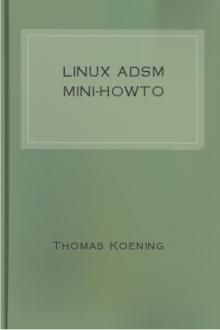How to Develop Accessible Linux Applications by Sharon Snider (most life changing books .txt) 📕

Developers need to consider the following needs of disabled users when developing an accessible application:
* Choice of input methods. Support should be available for various types of input, such as, keyboard, mouse and adaptive technologies. Pay close attention to keyboard navigation. * Choice of output methods. Support should be available for various types of output, such as, visual display, audio, and print. The main focus is that text labels are provided for all user interface elements and objects, graphics, and icons. * Consistency and flexibil
Read free book «How to Develop Accessible Linux Applications by Sharon Snider (most life changing books .txt) 📕» - read online or download for free at americanlibrarybooks.com
- Author: Sharon Snider
- Performer: -
Read book online «How to Develop Accessible Linux Applications by Sharon Snider (most life changing books .txt) 📕». Author - Sharon Snider
* There are no objects that display briefly and then hide information based
on the movement of the mouse pointer.3.11.2. Tests
Test the following for timing related to your application. You should verify
that:
* The user is notified before a message times out and is given the option
to indicate that more time is needed.* An option is available to adjust the response time and confirm that it is
working as designed.3.12. Documentation
3.12.1. Guidelines
The following are guidelines for writing accessible documentation:
* All documentation is in an accessible format (For example, HTML, or
text).* Documentation is available on all accessibility features of the
application.* State if the application does not support the standard keyboard access
that is used by the operating system.* Identify if there are unique keyboard commands.
* Identify and explain all accessibility features.
* When documenting mouse actions, include the alternative keyboard action
as well.3.12.2. Tests
Run the following test to verify that the documentation is available and
accessible.
* Open a help file while in the application using a screen reader or
Braille device and confirm the information is accessible, clear, and precise. Additional Resources:The following Web sites provide checklists and testing information that is
more specific to the various Linux development environments:
* American Foundation for the Blind provides information on creating
accessible applications at [http://www.afb.org/] http://www.afb.org/.* GNOME Accessibility Project has written a guide specifically for
application development in the GNOME 2.0 desktop. It includes information using their Accessibility Tool Kit (ATK). Additional information is available at [http://developer.gnome.org/projects/gap/guide/gad/ index.html] http://developer.gnome.org/projects/gap/guide/gad/index.html.* IBM Accessibility Center provides links to a Java, Web, and Software
accessibility checklist for application development. This site is located at [http://www-3.ibm.com/able/guidelines.html] http://www-3.ibm.com/able/ guidelines.html.* Sun Accessibility provides accessibility information on designing
accessible Java applications. More information is available at [http:// www.sun.com/access/developers/software.guide.html] http://www.sun.com/ access/developers/software.guide.html.* The Web Accessibility Initiative Web site includes guidelines,
checklists, and techniques for developing accessible Web sites and applications. Additional information is located at [http://www.w3.org/WAI /] http://www.w3.org/WAI/.




Comments (0)